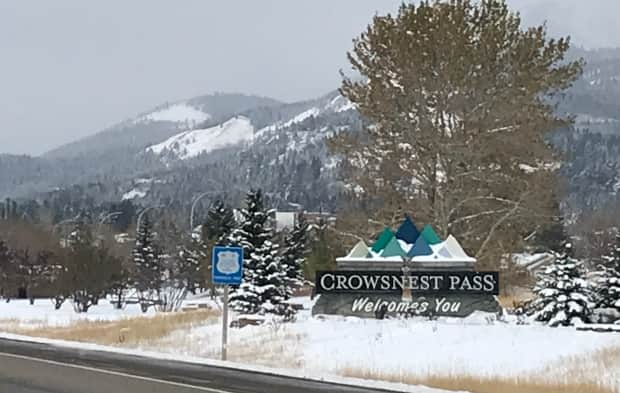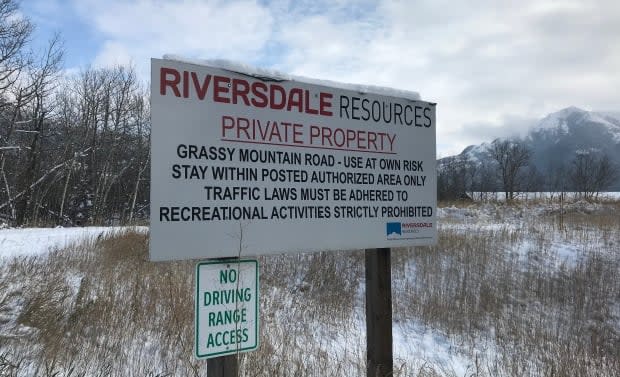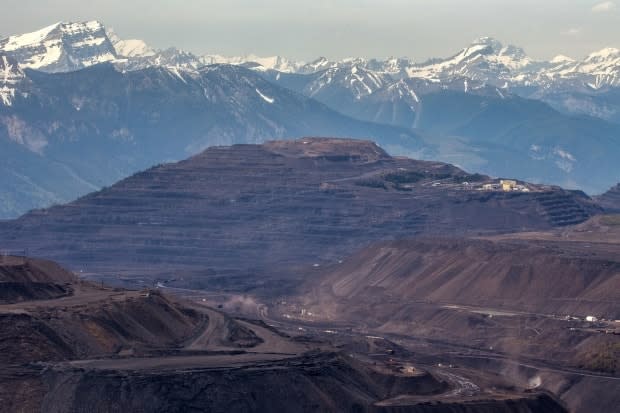Historic Alberta coal community wrestles with plans for new mining

Retired miner John Kinnear worked three decades in British Columbia's Elk Valley. His father was a mine surveyor. Both of his grandfathers worked in mining.
"I've been in it for a long time. I have an immense respect for mining history," said Kinnear, who retired just across the B.C.-Alberta border in Crowsnest Pass in southwest Alberta in 2011.
A few years ago, when Kinnear first heard about plans for a new coal mining project in the area — which would be the first in decades — the writer of mining history was cautiously optimistic. But now, he says he's torn.
Like others, he sees the need for an industry that could help lift the community's economy.
But he also hears the concerns of those worried about where things might lead if mining takes off again near this postcard setting of a town tucked at the foot of the Rocky Mountains.
"It's a double-edged sword," he said. "I am really, honest to God, stuck in the middle on this one."
As public hearings begin this week for the first major coal project the community has seen in years, debate continues over whether its future — like its past — should rest with coal.
Unlike most mines of the area's past, which tunnelled underground to access coal, this would be an open-pit mine. It involves breaking apart a mountain top, separating the rock, and hauling the valuable parts away.

The Municipality of Crowsnest Pass, which is nearly a three-hour drive southwest of Calgary, is actually a series of amalgamated towns that stretch east-west along Highway 3 in southwestern Alberta. These communities were built in the late 1800s and early 1900s when Canadian Pacific Rail, drawn by the area's vast coal deposits, extended its main line from Lethbridge westward along this route.
Mining was the lifeblood of Crowsnest Pass for most of the 20th century, but the last mine in the area closed in 1983.
The proposed Grassy Mountain project, located roughly seven kilometres north of Blairmore, would pick up where a previous mine left off. A section of the 1,500-hectare site has already been disturbed by previous mining activity decades ago.
Australia-based Riversdale Resources submitted a proposal to regulators in 2016 for the project, which it estimates could produce 4.5 million tonnes of steelmaking coal annually over the mine's 23-year lifespan. The company says this would create nearly 400 full-time jobs for the region.
And not just any jobs.
Some of the senior positions Riversdale has already advertised come with salaries well into six figures — a welcome boost to an area of Alberta with relatively low incomes.
The nearby Piikani First Nation has also officially supported the Grassy Mountain project.
But not everyone in the area welcomes the prospect of coal's return.
Controversy over open-pit mining
Grassy Mountain is a controversial project that has raised concerns about the impact it will have on wildlife, air and water quality, and the landscape.
Many look nervously at the environmental damage just over the border in B.C., where coal mines have led to many complaints over the years about black dust in the air, contaminated well water and mass deaths or deformations of rare fish.
Bill Trafford, who speaks for the Livingstone Landowners Group, which opposes open-pit mining in the area, understands the economic argument in favour of coal mining, and he's reviewed the Grassy Mountain project in detail. He doesn't think the risk-reward calculation makes sense.
"The risk to the environment and the water is huge," he said, "and the benefits are modest."
But others see it as a project that can be done responsibly while bringing jobs, businesses, people and economic development.
And it could be the first of several.
WATCH | Why Alberta is looking to the Rockies for coal:
Grassy Mountain is the closest to becoming reality, but several other mining projects that had been waiting in the wings are moving forward at the same time, buoyed by a change in government policy earlier this year that opens up vast new areas of Alberta that had been off limits to open-pit mining since 1976.
Much of this land lies just north of Crowsnest Pass.
In addition to jobs, new coal mines would also mean new taxes and royalties, though opponents contend it's not enough to make up for the impact they fear such projects could have on their surroundings.
Strong feelings
Located in the heart of Blairmore, the Stone's Throw Cafe is a popular destination for morning coffee and conversation. Owner Jessica Atkinson said one of the hot topics these days is the Grassy Mountain mine.
"People feel strongly, either way," she said.
It doesn't take much prodding to get customers talking.
Karey Watanabe, who runs a mountain bike instruction and tour company, is concerned about what a mining boom would mean for her business.
"People come here to recreate. People don't come here to see scenery of mines," said Watanabe, who once worked at a mine in B.C.
"If all three of those mines end up coming, I can guarantee that I'm going to be leaving," she said, referring to two other separate projects currently being discussed.

A couple of tables over, Jeff Paulsen, who worked with the mining sector in transportation for years, said he feels a "little conflicted" about what's best for the area.
He said he shares the same concerns about the impact on the environment as others, but said the community also needs good-paying jobs.
"And you don't make good paying jobs with just the restaurant industry," he said.
Crowsnest could use a boost
Some of Tim Juhlin's earliest memories of growing up in Crowsnest Pass are the big crowds that gathered for the parades and miners' union picnics that the bustling community celebrated.
"When it was thriving with mining, there was a lot going on," said Juhlin, 66, a retired professional forester.
The Alberta mines that had the community hopping back then have since closed. The community's population slid to 5,530 last year, down from 6,321 in 2001.
Juhlin and others like him hope people will see the community prosper again.
"I believe that we can have the development and be environmentally responsible as well," he said.
"What I hope is that we can find the right mix there so that we can have a community that has recreational users and workers, and also industrial workers."
Riversdale Resources says the Grassy Mountain project will create about 500 jobs during the two-year construction period, and roughly 400 full-time jobs for the project's 23-year operation.
It says the coal mine's operation is expected to contribute $490,000 a year in municipal taxes to Crowsnest Pass, plus $990,000 annually to neighbouring Ranchland, Alta.
The company estimates that — if metallurgical coal prices average around $140 US per tonne — it will pay more than $1.7 billion in royalties and taxes combined to the provincial and federal governments over the life of the mine.

Nearly two-thirds of that sum will stay in Alberta, though the size of the royalty payout will ultimately depend on coking coal markets and prices.
Crowsnest Pass Mayor Blair Painter said the project is important for the community and thinks most people support it.
"The benefits that we will have are increased tax revenue … plus others spin-off businesses that develop as a result of the mining industry," he said.
Painter said Crowsnest Pass is an intervenor in the joint review panel process and has a list of residents' concerns that they continue to monitor. But the mayor sounds hopeful the company can address them.
The company has said it will use industry-leading practices to manage water use, protect wildlife, and minimize noise and dust.
It also says it will restore habitat after an area is mined rather than waiting for mining to be completed, a move aimed at limiting the size of the project's overall footprint and accelerating restoration of wildlife habitat.
"We're a mining community," Painter added. "Our community was founded on coal."
Environmental concerns
The environmental concerns, however, extend well beyond the municipal borders of Crowsnest Pass.
More than 100 landowners nearby have banded together to oppose the Grassy Mountain project and coal mining in general. They fear new mines and related infrastructure will pollute waterways, damage ecosystems and affect cattle grazing.
"We have a fairly large group of what I call third-generation ranchers — so people whose parents or grandparents homesteaded down there," said Bill Trafford of Livingstone Landowners Group.
The group also includes various doctors, lawyers, businesspeople and other residents who don't love the idea of mountaintops being blasted apart near their backyards. They see the area as idyllic and rare.
"It's mountains and prairies mixed together," Trafford said.
"It's famous for having all of the large predators and every kind of elk, deer, sheep, you can think of. So you're actually taking something away that doesn't exist in many other places left in the world."

Katie Morrison worries about the water in particular.
As conservation director with the Canadian Parks and Wilderness Association's southern Alberta branch, she's closely studied the effects of coal mining just over the border in B.C.'s Elk Valley.
For years, the B.C. mines leached selenium into streams and rivers, despite efforts by mining giant Teck to control the pollution. Selenium is an element that can be toxic in large amounts and it has been routinely detected at levels well above guidelines in waterways downstream of the B.C. mines.
Selenium leaching has been linked to mass deaths of Westslope cutthroat trout and has sparked disputes with U.S. officials concerned about the pollution flowing over the border into Montana and Idaho.
Riversdale says Grassy Mountain will be different.

Gary Houston, the company's vice-president of external affairs of Riversdale Resources, says the project north of Blairmore was "specifically designed from the ground up to effectively capture and treat selenium in water sources."
"Our greatest advantage lies in being able to place waste rock in locations where we can maximize the ability to collect and treat any water that contains selenium," he said.
"There is a natural buffer zone along Blairmore and Gold Creeks to minimize impact to the aquatic environment and to leave migration routes for wildlife in the area."
Morrison has her doubts. She says the mitigations the company has proposed are "really new" and "fairly untested at the scale of a mine."
"When we look at the history of coal mining, both just over the border in the Elk Valley, as well as other places in North America, there has actually never been a case where the mine has successfully been able to mitigate and control selenium release," she said.
"So best laid-plans and intentions by the companies to mitigate, but I don't really have any confidence that things won't go wrong."
These competing concerns are expected to come up during weeks of public hearings, set to begin today, on the Grassy Mountain project. A joint review panel is scheduled to listen to supporters and opponents of the proposal for up to five weeks.
The hearings will be broadcast live here. A decision on the project is expected in 2021.


